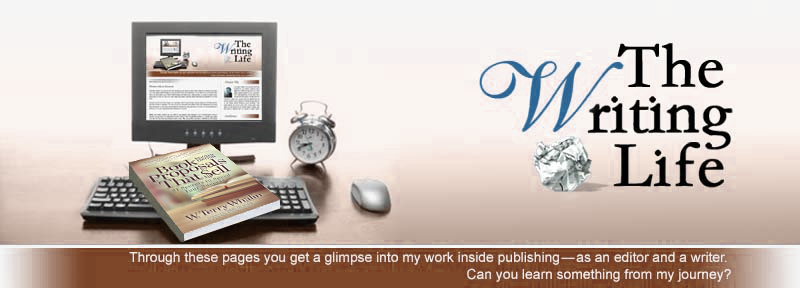____________________________________
Slow and Steady to Succeed in Publishing
Writers seem to have a litany of excuses why they can't get their writing done:
*They work full time.
*They have __ kids and a wife at home.
*They are tired in the evenings when they come home.
*They are active in their church.
*They have been sick or their child has been sick.
*They _____ (you fill it in).
From my experience their excuses will become a self-fulfilling prophecy and yes it will simply not happen. Because their writing isn't high enough on their daily priority list. You don't have to be writing every day but you do have to be writing on a regular basis to accomplish the writing and get it into the market. Even after you produce the writing, it doesn't get published unless you are regularly sending it to editors and agents.
People are always amazed at my writing resume or my amount of twitter followers or any number of other things. Here's the truth: it did not happen in a single day or a single month. The route to success in publishing is from slow and steady production. The route to more followers on twitter is working at it every day-slow and steady rules the day.
If you aren't getting published or aren't getting your work into print, then pull back and take a look at how you are using your time. Can you make some small change that will bring greater focus and commitment to your writing and work in the marketplace?
Maybe you get up an hour earlier or stay up an hour later or take your lunch time and work on your writing (or your coffee break at work). There are a million different possibilities and you need to get in touch with the micro decisions you are making each part of the day.
My encouragement to you is that you can do it. You can get published in magazines or books or whatever your goal. Yet to achieve it you have to work at it slow and steady with persistence and consistency. You may wonder how I have written for over 50 print magazines. It is slow and steady work. Or you may wonder how I've written many different types of books and over 60 books with traditional publishing houses (not self-published). Again it is slow and steady writing and working at it.
I've never pretended to be the best writer in the room or the best storyteller. I'm still working hard at learning my craft and attempting to get better every single day. Yet I am one of the most consistent. Just like when the tortoise raced the hare. The tortoise won because he was slow and steady. It will be your route to success in the publishing world as well.
As an action item, if you haven't read my Jumpstart Your Publishing Dreams, then I recommend you get a copy and work your way through each chapter and apply the material to your writing life. You can get the book through your local bookstore or my site or any number of other places.
Let me know how your writing is going and reach out to me if I can help you. I'm eager to see you succeed.




Labels: book, magazine, publishing, success, writing


____________________________________
How to Improve Your Twitter Followers
While it's great to have a lot of followers on twitter, how can you improve the quality of your followers?
As the twitter community grows, there are all sorts of fake profiles, profiles with no photo (which in general shows that the person doesn't care about their twitter account), and twitter accounts which are not in English (I don't like all of the non-English material in my twitter feed).
 In the last few days, I went over 64,000 followers. In this post, I'm going to show you a free tool that I'm using to improve my twitter followers. For the last several weeks, I've been using a FREE tool called Manage Flitter. There is a paid portion of this tool but I'm only using the free version.
When I log on to this tool, it takes several minutes for it to load all of my follower and check them out. Then in a matter of seconds, it shows me some key aspects:
*People who aren't following me but I'm following
*People who don't have a photo in their profile (indicates they don't use twitter much in the majority of cases)
*Fake or Spam twitter accounts
*Non-English Twitter accounts that I'm following
The program is easy to use and in a matter of a few minutes I can select these different groups and unfollow them quickly.
If you use Manage Flitter on a regular basis, you will improve the quality of your twitter followers. I hope it will become a good resource for you.
Tell me about your experience with Manage Flitter or other twitter tools. I'm always looking for ways to improve my Twitter account without spending loads of time on it.
In the last few days, I went over 64,000 followers. In this post, I'm going to show you a free tool that I'm using to improve my twitter followers. For the last several weeks, I've been using a FREE tool called Manage Flitter. There is a paid portion of this tool but I'm only using the free version.
When I log on to this tool, it takes several minutes for it to load all of my follower and check them out. Then in a matter of seconds, it shows me some key aspects:
*People who aren't following me but I'm following
*People who don't have a photo in their profile (indicates they don't use twitter much in the majority of cases)
*Fake or Spam twitter accounts
*Non-English Twitter accounts that I'm following
The program is easy to use and in a matter of a few minutes I can select these different groups and unfollow them quickly.
If you use Manage Flitter on a regular basis, you will improve the quality of your twitter followers. I hope it will become a good resource for you.
Tell me about your experience with Manage Flitter or other twitter tools. I'm always looking for ways to improve my Twitter account without spending loads of time on it.


Labels: followers, Manage Flitter, social media, social networking, Twitter


____________________________________
Why Writers Need to Know their Word Count
As I work with different authors, one of the first questions I often ask is about the size of their manuscript.
I met with a book author yesterday and her response was, “about 350 pages.”
I wasn't looking for the number of pages in her manuscript because the type of font and size can vary from author to author. Here's what does not change: words. What is the word count for your manuscript? Many writers are unaware of the word count.
Possibly they have written their chapters in different files and haven't added up the words. Maybe they are focused on completing their writing and haven't thought about the length or only the page count.
I meet a lot of authors who have never looked at the word count portion of Microsoft Word even though they use the program to create their book. If you are writing your manuscript in a single file, the word count is normally in the lower left hand portion of your screen and that information is always available—yet many writers have overlooked it and instead they want to tell me how many pages they've written—which doesn't give me much insight and information.
Why do I care about the word count? I've been in publishing many years and with this information, I can easily estimate the size of the printed book. I can learn if the writer is in touch with this detail as they have written the book. Our sales representative tell us that shorter nonfiction is better received in the bookstores. From my perspective, that means your book should be closer to 200 pages than 300 or 350 pages. For most nonfiction topics, 350 pages is too long and the writer has belabored the topic.
As the book grows longer, it also increases the production costs (more paper and ink) and potentially raises the retail price for the book. Yes all of these calculations or expectations are made on the front end of the book production process when you meet with an acquisitions editor.
My goal for you is to get your book published and champion your book to my publication board so they will issue you a book contract. We receive about 5,000 submissions a year and only publish about 150 books. If I manage to get you a book contract, that's a big hurdle that you've jumped across and should feel great about accomplishing.
A typical nonfiction book is running about 40,000 to 50,000 words or about 200 pages. Some books are shorter and some books are longer but that's a general word count that you should be aiming for in your writing for nonfiction. If you are writing a novel, then that is a different story. Follow this link to see my post about word length for novels.
Whenever you pitch an editor or agent, you have to have a terrific book. Good writing is foundational to any type of book—yet you also need to clearly have the details about your book such as the word count in hand to be able to intelligently answer questions.
Agents and editors are looking for smart savvy authors who are articulate and also good writers. If you have a book, keep growing in your craft and keep building relationships. Eventually you will have a winning combination and get published.




Labels: acquisitions editor, agent, editor, publishing, word count, writers


____________________________________
The Necessity of Simple Follow-up
Good and clear communication is a critical element in the business of publishing. Otherwise authors and editors have wrong expectations.
Last week I was at Wheaton College for Write to Publish. During the question and answer portion of a workshop, a woman asked, “I sent my manuscript to an editor who asked for it at the last conference. I never heard and checked on it about six months later. When I called, the editor said she had not received it and could I send it again. I sent it a second time. Now it is six month's later and I've heard nothing. What do I do?”
 See the challenge for the author? She has been waiting for a response to a requested submission and hearing nothing. This new writer is too timid to email or call and check with the editor about it. I understand the reluctance because sometimes when you check, it gets rejected—and no one wants to be rejected.
Here's what the writer isn't thinking about. As editors, we receive a lot of material. For example, at Morgan James, we receive over 5,000 submissions a year and only publish about 150 books. Did you see those numbers? A massive amount of material is floating through our system at any single time period. I'm constantly putting submissions into our system and sorting through my acquisitions files.
To be transparent, other editors are not as careful with their submissions. It is not uncommon for me to receive several hundred emails a day. If I'm traveling or at a conference, then I can't be as conscious of my email and the submissions. Manuscripts, proposals and submissions are misplaced and some times the editor doesn't receive them. Or maybe they have moved into a new computer or their computer has crashed or any number of other possibilities.
Here's what I suggested to the writer asking about her manuscript: follow-up with the editor. Don't wait weeks yet at the same time give it at least a week so you don't seem overly anxious. Then you can email or put in a quick phone call to the editor asking, “Did you receive my submission?” Notice the question. You are not asking if the editor has read it or reached a decision—which if you ask is pushing them to say, “no.” Instead you are simply asking if they received it.
You avoid waiting months for a response, hearing nothing and then asking only to learn the editor never received it. I never mind an author checking with me to see if I received their material and this simple follow-up is professional and appreciated.
Other authors are extreme in the other direction of follow-up. They follow-up too frequently and often. I have a children's author who submitted their material three weeks ago. I got their material into our submission system and they received an acknowledgement from me in the mail. In addition, I emailed the author to tell him I received his submission. Yet, in the last several weeks, I've been in Seattle, New York City and last week Chicago. With my travel, I have not been processing manuscripts. Yet this author has called multiple times—essentially making himself a nuisance. In my last email to him, I leveled with him and asked for patience—and no more calls or checking—or I would be rejecting his submission. I've not heard from him in the last few days so hopefully he is following my last instructions or I will follow through with the rejection letter (whether I've read his material or not).
Why take such a direct response with this eager author? Because if he is eager with his submission then he is showing that he will be eager throughout the entire publication process. You can substitute my use of the word “eager” with the word “high maintenance.” No publisher wants high maintenance authors. Every publisher wants to work with professionals and not with eager authors who simply waste volumes of time and energy over nothing.
If you are submitting your work, that is excellent. Many writers never get published because of this simple fact: they never submit their material. As a professional writer, you also need to use this simple follow-up method to make sure that your material was received. It will help your work be considered and move forward through the publication process. This follow-up work is critical.
See the challenge for the author? She has been waiting for a response to a requested submission and hearing nothing. This new writer is too timid to email or call and check with the editor about it. I understand the reluctance because sometimes when you check, it gets rejected—and no one wants to be rejected.
Here's what the writer isn't thinking about. As editors, we receive a lot of material. For example, at Morgan James, we receive over 5,000 submissions a year and only publish about 150 books. Did you see those numbers? A massive amount of material is floating through our system at any single time period. I'm constantly putting submissions into our system and sorting through my acquisitions files.
To be transparent, other editors are not as careful with their submissions. It is not uncommon for me to receive several hundred emails a day. If I'm traveling or at a conference, then I can't be as conscious of my email and the submissions. Manuscripts, proposals and submissions are misplaced and some times the editor doesn't receive them. Or maybe they have moved into a new computer or their computer has crashed or any number of other possibilities.
Here's what I suggested to the writer asking about her manuscript: follow-up with the editor. Don't wait weeks yet at the same time give it at least a week so you don't seem overly anxious. Then you can email or put in a quick phone call to the editor asking, “Did you receive my submission?” Notice the question. You are not asking if the editor has read it or reached a decision—which if you ask is pushing them to say, “no.” Instead you are simply asking if they received it.
You avoid waiting months for a response, hearing nothing and then asking only to learn the editor never received it. I never mind an author checking with me to see if I received their material and this simple follow-up is professional and appreciated.
Other authors are extreme in the other direction of follow-up. They follow-up too frequently and often. I have a children's author who submitted their material three weeks ago. I got their material into our submission system and they received an acknowledgement from me in the mail. In addition, I emailed the author to tell him I received his submission. Yet, in the last several weeks, I've been in Seattle, New York City and last week Chicago. With my travel, I have not been processing manuscripts. Yet this author has called multiple times—essentially making himself a nuisance. In my last email to him, I leveled with him and asked for patience—and no more calls or checking—or I would be rejecting his submission. I've not heard from him in the last few days so hopefully he is following my last instructions or I will follow through with the rejection letter (whether I've read his material or not).
Why take such a direct response with this eager author? Because if he is eager with his submission then he is showing that he will be eager throughout the entire publication process. You can substitute my use of the word “eager” with the word “high maintenance.” No publisher wants high maintenance authors. Every publisher wants to work with professionals and not with eager authors who simply waste volumes of time and energy over nothing.
If you are submitting your work, that is excellent. Many writers never get published because of this simple fact: they never submit their material. As a professional writer, you also need to use this simple follow-up method to make sure that your material was received. It will help your work be considered and move forward through the publication process. This follow-up work is critical.




Labels: acquisitions editor, follow-up, manuscript, Morgan James Publishing, rejection, submission


____________________________________
The Risk-Taking Writer
This weekend I returned from Book Expo, the largest book trade show in the United States in New York City. A trade show requires the attendees to wear a badge to get into the event and the entrances are closely monitored.
The floor of Book Expo is filled with librarians and booksellers from around the world. The exhibits are large and small publishers who are showing off their forthcoming books and authors. The aisles are full of well-known and unknown authors. For example, I saw journalist and political commentator Chris Matthews in the Simon and Schuster area signing the paperback version of his New Times bestseller, Jack Kennedy.
From my years in publishing I know that every book which is published is a risk. No one knows if the book will sell or not. The publishing professionals make their best effort and put the book into the market. Book Expo or trade shows like it are one more way that an author can get exposure for their book.
One of the foundational keys is to take calculated risks in publishing. First and foremost a good book is based on an excellent manuscript. Good writing is critical.
As I walked around the massive floor, I saw some unusual risk takers. For example, I met one new publisher with three full color picture books. While the art work was beautiful, I looked at the story and it seemed to have a lot of words for a picture book.
I mentioned this concern to the publisher and he instantly launched into how they are creating a new category of picture book which he called the picture book/ chapter book. I listened but skeptically. The children's book market is very particular. The age category and the expectations from retailers and librarians and others is almost impossible to shift or “add a new category.”
I wish this new publisher nothing but the best but from my years in this market, I could see some potential pitfalls in his book launch. I hope he proves me wrong and sells thousands of copies of his beautiful books.
The Book Expo was an excellent event in my view because of the opportunity to meet with literary agents and authors. On the final day of the event, Saturday, the public could purchase tickets to attend and someone told me that over 600 people were waiting in line to be able to enter the exhibit floors. I was grateful for the opportunity attend and learn from the experience and new relationships.
My encouragement to you as a writer is to take calculated risks. Every bit of writing that I've done for years involves risk. Every writer can:
And in the area of conferences, tomorrow I'm headed to Chicago to be on the faculty of Write to Publish at Wheaton College tomorrow. I hope to see some of you at this event. Or possibly you can attend a conference later in the year (follow the link) and we can have some face to face time. I look forward to it.



Labels: Book Expo, children's books, conferences, nonfiction, picture books, relationships, risk






























